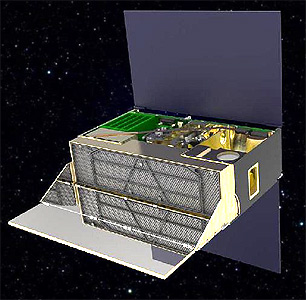Thank you very much for visiting Gunter's Space Page. I hope that this site is useful and informative for you.
If you appreciate the information provided on this site, please consider supporting my work by making a simple and secure donation via PayPal. Please help to run the website and keep everything free of charge. Thank you very much.
HyperCube

HyperCube [Harris]
HyperCube is a 6U CubeSat mission developed at the Harris. It is a space-based threedimensional sounding instrument designed to measure the speed, direction, and elevation of wind in Earth’s atmosphere. A Fourier Transform Spectrometer, the HyperCube cubesat is much smaller and less expensive, and offers a more expedient implementation alternative to complex LiDAR wind measurement programs.
The satellite are developed in connection with the Space Dynamics Lab of Utah State University, who provides the spacecraft for the HyperCube mission.
HyperCube provides hundreds of hyperspectral bands for the best instrument resolution in the small satellite market. It delivers more vertical layers of wind vector data at fine spatial resolution, resulting in more accurate data than other available solutions. Data accuracy is maintained using an onboard calibration target capable of precise, absolute calibration. HyperCube also offers collection time flexibility, allowing for more mission coverage than alternative technologies.
HyperCube serves as a technology demonstration for a 12 cubesat constellation, which could provide optimum wind measurements. A 15-minute time separation provides a “slice” of atmospheric measurements to identify wind vectors. The constellation delivers global coverage twice every day at the equator, and more frequently at higher latitudes.
The instruments are:
- Scanner: The scanner consists of two mirrors that work together to reflect infrared light from the atmosphere toward the interferometer, resulting in greater efficiency and with fewer data gaps than with one mirror. The HyperCube scanner is a miniature version of the two-mirror scanner used by the Harris Advanced Baseline Imager on NOAA’s GOES-R series weather satellites.
- Interferometer: The interferometer consists of a laser, a series of mirrors, and a light sensor—detecting more than 600 channels of infrared light from the atmosphere to measure the vertical distribution of moisture at 1-kilometer vertical resolution. The HyperCube interferometer is a miniature version of the interferometer used by the Harris Cross-track Infrared Sounder on NOAA’s JPSS series weather satellites.
- Focal Plane Array (FPA): The planned operational HyperCube FPA is a state-of-the-art sensor consisting of a 25×25 array of pixels that convert the infrared light into a digital signal. The HyperCube FPA is larger and has more pixels than previous instruments, allowing it to collect more data faster.
The technology demonstrator will be launched in 2019.
| Nation: | USA |
|---|---|
| Type / Application: | Experimental |
| Operator: | Harris |
| Contractors: | Harris (prime), Space Dynamics Laboratory, (bus) |
| Equipment: | Hyperspectral mid-wave infrared Fourier Transform Spectrometer |
| Configuration: | CubeSat (6U) |
| Propulsion: | None |
| Power: | Deployable solar arrays, batteries |
| Lifetime: | |
| Mass: | 12 kg |
| Orbit: |
| Satellite | COSPAR | Date | LS | Launch Vehicle | Remarks | |
|---|---|---|---|---|---|---|
| HyperCube 1 | - | 202x | with ? |
References:
- Harris: HyperCube™ 3D Wind Measurement
